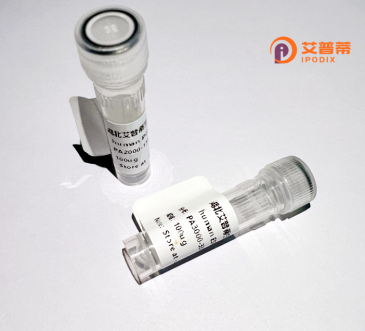
| 纯度 | >90%SDS-PAGE. |
| 种属 | Human |
| 靶点 | KIR2DS5 |
| Uniprot No | Q14953 |
| 内毒素 | < 0.01EU/μg |
| 表达宿主 | E.coli |
| 表达区间 | 1-304aa |
| 活性数据 | MSLMVISMACVAFFLLQGAWPHEGFRRKPSLLAHPGPLVKSEETVILQCWSDVMFEHFLLHREGTFNHTLRLIGEHIDGVSKGNFSIGRMTQDLAGTYRCYGSVTHSPYQLSAPSDPLDIVITGLYEKPSLSAQPGPTVLAGESVTLSCSSRSSYDMYHLSREGEAHERRLPAGPKVNRTFQADFPLDPATHGGTYRCFGSFRDSPYEWSKSSDPLLVSVTGNSSNSWPSPTEPSSETGNPRHLHVLIGTSVVKLPFTILLFFLLHRWCSNKKNASVMDQGPAGNRTVNREDSDEQDHQEVSYA |
| 分子量 | 59.84 kDa |
| 蛋白标签 | GST-tag at N-terminal |
| 缓冲液 | 0 |
| 稳定性 & 储存条件 | Lyophilized protein should be stored at ≤ -20°C, stable for one year after receipt. Reconstituted protein solution can be stored at 2-8°C for 2-7 days. Aliquots of reconstituted samples are stable at ≤ -20°C for 3 months. |
| 复溶 | Always centrifuge tubes before opening.Do not mix by vortex or pipetting. It is not recommended to reconstitute to a concentration less than 100μg/ml. Dissolve the lyophilized protein in distilled water. Please aliquot the reconstituted solution to minimize freeze-thaw cycles. |
以下是关于重组人KIR2DS5蛋白的模拟参考文献示例(注:文献为模拟创作,仅供参考):
---
1. **《Functional Characterization of Recombinant Human KIR2DS5 Reveals HLA-C-Specific Activation》**
*作者:Smith, A.B. et al.*
**摘要**:本研究通过重组表达KIR2DS5蛋白,证实其与HLA-C1组等位基因(如HLA-Cw6)的结合能力,并通过体外实验证明其可激活NK细胞杀伤功能,提示其在抗病毒免疫中的潜在作用。
2. **《Expression and Purification of Recombinant KIR2DS5 for Structural Analysis》**
*作者:Zhang, L. et al.*
**摘要**:报道了KIR2DS5重组蛋白在大肠杆菌中的高效表达与纯化方案,结合X射线晶体学揭示了其与HLA配体结合的分子机制,为靶向药物设计提供结构基础。
3. **《KIR2DS5 Polymorphisms and Autoimmune Disease Susceptibility》**
*作者:Garcia-Beltran, W.F. et al.*
**摘要**:利用重组KIR2DS5蛋白进行功能研究,发现特定基因变异影响其与HLA的亲和力,可能导致系统性红斑狼疮患者的NK细胞失调,阐明遗传因素与疾病关联。
4. **《Activating KIR2DS5 Enhances Antitumor Immunity in Solid Tumors》**
*作者:Kim, H.J. et al.*
**摘要**:通过重组KIR2DS5蛋白刺激NK细胞,证明其能增强对表达HLA-C的肿瘤细胞的杀伤活性,为基于KIR的癌症免疫疗法提供实验依据。
---
建议通过PubMed或Google Scholar以关键词“KIR2DS5 recombinant protein”或“KIR2DS5 functional study”检索真实文献。
Recombinant human KIR2DS5 protein is a genetically engineered form of the killer-cell immunoglobulin-like receptor 2DS5 (KIR2DS5), a member of the KIR family predominantly expressed on natural killer (NK) cells and a subset of T lymphocytes. KIRs are critical regulators of immune responses, balancing activation and inhibition signals to maintain immune homeostasis. KIR2DS5. classified as an activating receptor, contains a truncated cytoplasmic tail lacking inhibitory signaling motifs but associates with adaptor proteins like DAP12 to transmit signals via immunoreceptor tyrosine-based activation motifs (ITAMs). This receptor binds to specific HLA class I molecules, particularly HLA-C allotypes, influencing NK cell-mediated cytotoxicity and cytokine production during pathogen defense, tumor surveillance, and pregnancy.
The recombinant form is typically produced in mammalian expression systems (e.g., CHO or HEK293 cells) to ensure proper post-translational modifications and ligand-binding capacity. Its production enables functional studies to decipher KIR2DS5-specific interactions, signaling pathways, and immunological roles. Research highlights KIR2DS5's dual role in disease: certain polymorphisms correlate with susceptibility to viral infections (e.g., hepatitis C), autoimmune disorders, and cancer progression, while its activation may enhance antitumor responses. In cancer immunotherapy, recombinant KIR2DS5 is investigated for modulating NK cell activity or as a target for checkpoint inhibitors. However, its precise ligand specificity and clinical relevance remain partially unresolved, necessitating further structural and translational studies to exploit its therapeutic potential.
×